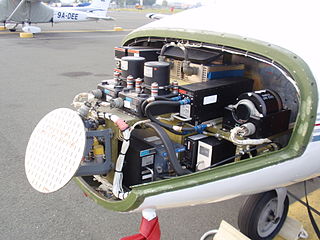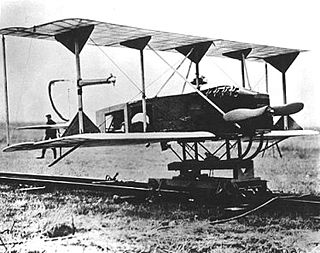Related Research Articles

Avionics are the electronic systems used on aircraft. Avionic systems include communications, navigation, the display and management of multiple systems, and the hundreds of systems that are fitted to aircraft to perform individual functions. These can be as simple as a searchlight for a police helicopter or as complicated as the tactical system for an airborne early warning platform.

A gyroscope is a device used for measuring or maintaining orientation and angular velocity. It is a spinning wheel or disc in which the axis of rotation is free to assume any orientation by itself. When rotating, the orientation of this axis is unaffected by tilting or rotation of the mounting, according to the conservation of angular momentum.

An auxiliary power unit (APU) is a device on a vehicle that provides energy for functions other than propulsion. They are commonly found on large aircraft and naval ships as well as some large land vehicles. Aircraft APUs generally produce 115 V AC voltage at 400 Hz, to run the electrical systems of the aircraft; others can produce 28 V DC voltage. APUs can provide power through single or three-phase systems.

Sperry Corporation was a major American equipment and electronics company whose existence spanned more than seven decades of the 20th century. Sperry ceased to exist in 1986 following a prolonged hostile takeover bid engineered by Burroughs Corporation, which merged the combined operation under the new name Unisys. Some of Sperry's former divisions became part of Honeywell, Lockheed Martin, Raytheon Technologies, and Northrop Grumman.

The Robert J. Collier Trophy is an annual aviation award administered by the U.S. National Aeronautic Association (NAA), presented to those who have made "the greatest achievement in aeronautics or astronautics in America, with respect to improving the performance, efficiency, and safety of air or space vehicles, the value of which has been thoroughly demonstrated by actual use during the preceding year."

An autopilot is a system used to control the path of an aircraft, marine craft or spacecraft without requiring constant manual control by a human operator. Autopilots do not replace human operators. Instead, the autopilot assists the operator's control of the vehicle, allowing the operator to focus on broader aspects of operations.

Elmer Ambrose Sperry Sr. was an American inventor and entrepreneur, most famous for construction, two years after Hermann Anschütz-Kaempfe, of the gyrocompass and as founder of the Sperry Gyroscope Company. He was known as the "father of modern navigation technology".

A glass cockpit is an aircraft cockpit that features electronic (digital) flight instrument displays, typically large LCD screens, rather than the traditional style of analog dials and gauges. While a traditional cockpit relies on numerous mechanical gauges to display information, a glass cockpit uses several multi-function displays driven by flight management systems, that can be adjusted to display flight information as needed. This simplifies aircraft operation and navigation and allows pilots to focus only on the most pertinent information. They are also popular with airline companies as they usually eliminate the need for a flight engineer, saving costs. In recent years the technology has also become widely available in small aircraft.

The Hewitt-Sperry Automatic Airplane was a project undertaken during World War I to develop a flying bomb, or pilotless aircraft capable of carrying explosives to its target. It is considered by some to be a precursor of the cruise missile.

Preston Rogers Bassett was an inventor, engineer, and pioneer in instruments for aviation.
John Robert Woodyard (1904–1981) was an American physicist who made important contributions to the technology of microwave electronics and invented "doping" to improve the performance of semiconductors.
Honeywell Aerospace is a manufacturer of aircraft engines and avionics, as well as a producer of auxiliary power units (APUs) and other aviation products. Headquartered in Phoenix, Arizona, it is a division of the Honeywell International conglomerate. It generates approximately $10 billion in annual revenue from a 50/50 mix of commercial and defense contracts.
Maynard L. Pennell was a Boeing executive and aircraft designer.

An inertial navigation system (INS) is a navigation device that uses motion sensors (accelerometers), rotation sensors (gyroscopes) and a computer to continuously calculate by dead reckoning the position, the orientation, and the velocity of a moving object without the need for external references. Often the inertial sensors are supplemented by a barometric altimeter and sometimes by magnetic sensors (magnetometers) and/or speed measuring devices. INSs are used on mobile robots and on vehicles such as ships, aircraft, submarines, guided missiles, and spacecraft. Other terms used to refer to inertial navigation systems or closely related devices include inertial guidance system, inertial instrument, inertial measurement unit (IMU) and many other variations. Older INS systems generally used an inertial platform as their mounting point to the vehicle and the terms are sometimes considered synonymous.
The NAS Award in Aeronautical Engineering, also known as the J.C. Hunsaker Award in Aeronautical Engineering, is awarded by the U.S. National Academy of Sciences "for excellence in the field of aeronautical engineering." Established by Jerome C. Hunsaker and his wife, it was first awarded in 1968.
Edward J. Wasp (1923–2015), also known as E. J. Wasp, was an American engineer and inventor who developed long distance slurry pipelines for the transportation of coal and other solid materials. Wasp, born in New York City, earned a bachelor's degree in chemical engineering from Cooper Union, a master's degree in mathematics from the University of Pittsburgh, and an MBA from Golden Gate University. He began experimenting with coal slurries in a systematic manner when he worked for Consolidation Coal Company in the early 1950s. Wasp combined works of scientists and engineers and developed a model that related homogeneous and heterogeneous "flow characteristics" of slurry for the design of long-distance pipelines. He was in charge of the world's first long-distance coal pipeline, a 108-mile system within Ohio completed in 1957.
The gyroscopic autopilot was a type of autopilot system developed primarily for aviation uses in the early 20th century. Since then, the principles of this autopilot has been the basis of many different aircraft control systems, both military and civilian.
Claud M. Davis was an American engineer, inventor, and employee of the IBM Corporation at Poughkeepsie, New York. He was known for his contributions to the development of the IBM System/360 and the development of air traffic control systems.
John J. Tracy is the retired Chief Technology Officer (CTO) of The Boeing Company, the world's largest aerospace company. At Boeing, he held the dual roles of CTO and Senior Vice President of Engineering, Operations & Technology from June 2006 to mid 2016.
Harri U. Kulovaara is a Finnish naval architect and the Executive Vice President for Maritime & Newbulding for Royal Caribbean Cruises Ltd.
References
- ↑ "Honeywell's Don Bateman Named 2013 Recipient Of Elmer A. Sperry Award For Advancing Flight Safety". Honeywell. Retrieved 13 November 2015.
- ↑ "Sperry Award" (PDF). Archived from the original (PDF) on 17 November 2015. Retrieved 13 November 2015.
- ↑ "Boeing 787-8 Development Team to Receive the 2015 Elmer A. Sperry Award". American Institute of Aeronautics and Astronautics. Archived from the original on 4 February 2017. Retrieved 3 February 2017.
- ↑ Society of Naval Architects and Marine Engineers (February 21, 2017). "2016 Elmer A. Sperry Award - Harri Kulovaara". Vimeo.
- ↑ "Exit interview' with Carlo Bozotti of STMicroelectronics".